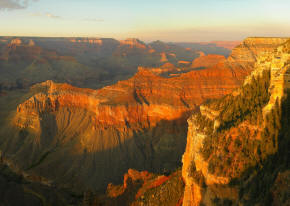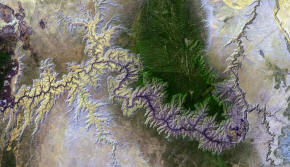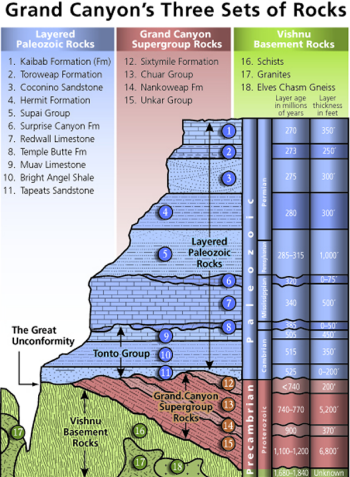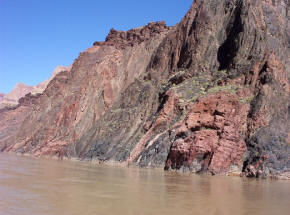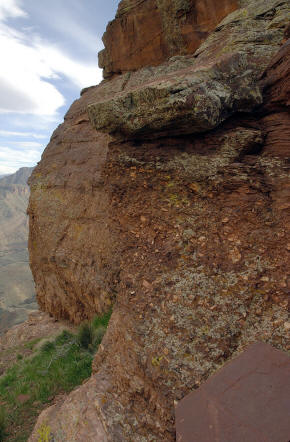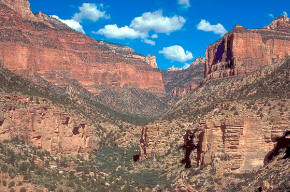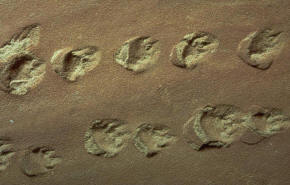the
Grand Canyon and in the
Grand Canyon National Park area range in age from about 200 million to
nearly 2 billion years old. Most were deposited in warm, shallow seas and
near ancient, long-gone sea shores in western North America. Both marine and
terrestrial sediments are represented, including fossilized
sand dunes from an extinct desert. There are at least 14 known
unconformities in the geologic record found in the Grand Canyon area.
Uplift of the region started about 75 million years ago in the
Laramide orogeny; a mountain-building event that is largely responsible
for creating the
Rocky Mountains to the east. In total the
Colorado Plateau was uplifted an estimated 2 miles (3.2 km). The
adjacent
Basin and Range province to the west started to form about 18 million
years ago as the result of crustal stretching. A drainage system that flowed
through what is today the eastern Grand Canyon emptied into the now lower
Basin and Range province. Opening of the
Gulf of California around 6 million years ago enabled a large river to
cut its way northeast from the gulf. The new river captured the older
drainage to form the ancestral
Colorado River, which in turn started to form the Grand Canyon.
Wetter climates brought upon by
ice ages
starting 2 million years ago greatly increased excavation of the Grand
Canyon, which was nearly as deep as it is now by 1.2 million years ago.
Volcanic
activity deposited lava over the area 1.8 million to 500,000 years ago. At least 13 lava
dams blocked the Colorado River, forming lakes that were up to 2,000 feet
(610 m) deep. The end of the ice age and subsequent human activity has
greatly reduced the ability of the Colorado River to excavate the canyon.
Dams in particular have upset patterns of sediment transport and deposition.
Controlled floods from
Glen Canyon Dam upstream have been conducted to see if they have a
restorative effect. Earthquakes and
mass wasting erosive events still affect the region.
Metamorphic and Igneous Basement
The Granite Gorge Metamorphic Suite consists of the metasedimentary
Vishnu Schist and the metavolcanic Brahma and Rama Schists. All were formed
1.75 billion to 1.73 billion years ago
in Precambrian time when thousands of feet of
volcanic ash, mud, sand, and
silt were laid
down in a shallow
backarc basin similar to the modern
Sea
of Japan.
The basin was between an early form of North America called
Laurentia
and an
orogenic belt of mountains and volcanoes in an
island
arc similar to modern Japan.
From 1.8 to 1.6 billion years ago at least two
island
arcs collided with the proto-North
American
continent.
This process of
plate tectonics compressed and grafted these marine sediments onto
Laurentia and uplifted them out of the sea. Later, these rocks were buried
12 miles (19 km) under the surface and pressure-cooked into
metamorphic rock.
This is the resistant rock now exposed at the bottom of the canyon in the
Inner Gorge. No identifiable fossils have been found in the Suite, but
lenses of marble now seen in these units were likely derived from colonies
of primitive algae.
As the volcanic islands collided with the mainland around 1.7 billion
years ago, blobs of
magma rose
from the
subduction zone and intruded the Granite Gorge Metamorphic Suite.
These
plutons slowly cooled to form the Zoroaster Granite; part of which would
later be metamorphosed into
gneiss.
This rock unit can be seen as light-colored bands in the darker
garnet-studded
Vishnu Schist (see 1b in Figure 1). The intrusion of the granite occurred in
three phases: two during the initial Vishnu metamorphism period, and a third
around 1.4 billion years ago.
The third phase was accompanied by large-scale
faulting, particularly along north—south faults, leading to a partial
rifting of the continent.
The collision expanded the continent from the
Wyoming–Colorado
border into Mexico and almost doubled the crust's thickness in the Grand
Canyon region.
Part of this thickening created the 5-to-6-mile (8 to 10 km) high ancestral
Mazatzal Mountains.
Subsequent erosion lasting 300 million years stripped much of the exposed
sediments and the mountains away.
This reduced the very high mountains to small hills a few tens to hundreds
of feet (tens of meters) high.
Geologist
John Wesley Powell called this major gap in the geologic record, which
is also seen in other parts of the world, the
Great Unconformity.
Other sediments may have been added but, if they ever existed, were
completely removed by erosion. Such gaps in the
geologic record are called
unconformities by geologists. The Great Unconformity is one of the best
examples of an exposed
nonconformity, which is a type of unconformity that has bedded rock
units above
igneous or
metamorphic rocks.
Deposition of Sedimentary Layers
Grand Canyon Supergroup
In late Precambrian time, extension from a large
tectonic plate or smaller plates moving away from
Laurentia
thinned its
continental crust, forming large
rift basins that would ultimately fail to split the continent.
Eventually, this sunken region of Laurentia was flooded with a shallow
seaway that extended from at least present-day
Lake Superior to
Glacier National Park in
Montana
to the Grand Canyon and the
Uinta Mountains.
The resulting Grand Canyon Supergroup of sedimentary units formed by this
shallow seaway is composed of
nine varied
geologic formations that were laid down from 1.2 billion and 740 million
years ago in this sea.
Good exposures of the supergroup can be seen in eastern Grand Canyon in the
Inner Gorge and from Desert View, Lipan Point and Moran point.
The oldest section of the supergroup is the
Unkar Group. It was laid down in an offshore environment. The first
formation to be laid down in the Unkar Group was the Bass Limestone.
The Bass Limestone was deposited in a shallow sea near the coast as a mix of
limestone,
sandstone,
and
shale. It
is 120 to 340 feet (37 to 100 m) thick and grayish in color.
Averaging 1250 million years old, this is the oldest layer exposed in the
Grand Canyon that contains fossils—stromatolites.
The next layer is the Hakatai Shale. It is made of thin beds of marginal-marine-derived
mudstones,
sandstones, and shale that, together, are 445 to 985 feet (136 to 300 m)
thick.
This formation indicates a short-lived regression (retreat) of the seashore
in the area that left mud flats.
Today it is very bright orange-red and gives the Red Canyon its name.
Shinumo Quartzite was a resistant marine sandstone that later formed islands
in Cambrian
time. Those islands withstood wave action long enough to become re-buried by
other sediments in the Cambrian Period.
It was later metamorphosed into
quartzite.
Dox Sandstone is over 3,000 feet (910 m) thick and is made of ocean-derived
sandstone with some interbedded shale beds and mudstone.
Ripple marks and other features indicate it was close to the shore.
Outcrops of this red to orange formation can be seen in the eastern parts of
the canyon. Fossils of stromatolites and algae are found in this layer. At
1070 ± 70 million years old, the Cardenas Lava is the youngest formation in
the Unkar Group.
It is made of layers of dark brown
basaltic
rocks that flowed as
lava up to
1,000 feet (300 m) thick.
Nankoweap Formation is around 1050 million years old and is not part of
a group.
This rock unit is made of coarse-grained sandstone, and was deposited in a
shallow sea on top of the eroded surface of the Cardenas Lava.
The Nankoweap is only exposed in the eastern part of the canyon. A gap in
the geologic record, an unconformity, follows the Nankoweap.
All formations in the
Chuar Group were deposited in coastal and shallow sea
